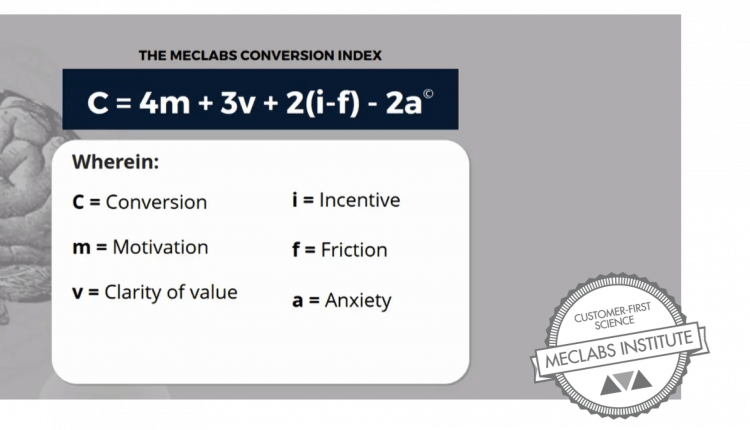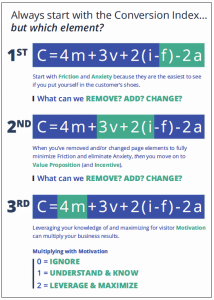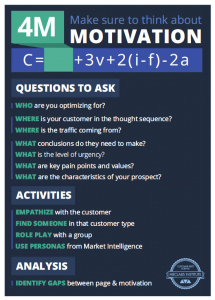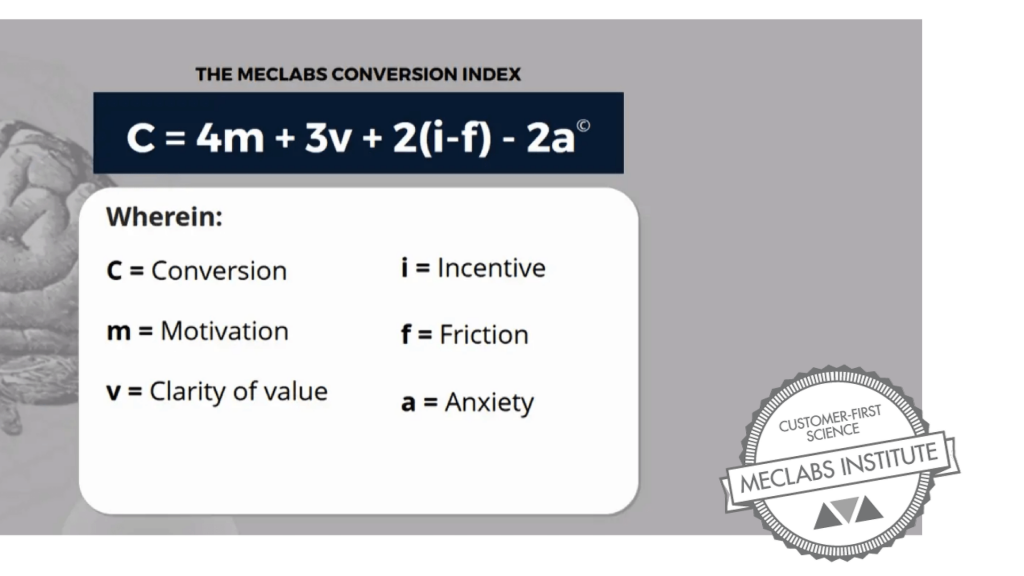All conversion optimization begins with the customer. Why are some customers leaving your website? Why are others buying? Why are they coming to your website in the first place?
A repeatable methodology to help you focus on the customer is the MECLABS Institute Conversion Index heuristic. Longtime readers of MarketingExperiments are already familiar with the Conversion Index.
But today we’re releasing a new tool to help you get the most value from it – a two-page PDF you can print out and hang in your office. It’s a simple guide for how to use the Conversion Index, with a deeper focus on the most powerful element — motivation. Use it to give you ideas for implementing the Conversion Index in your long-term strategy as well as your day-to-day marketing.
Here is an instant download of the free PDF. Read below for a deeper explanation to help you put this information into action.
Click Here to Download Your FREE CRO Cheat Sheet Instantly
(no form to fill out, just click to get your instant download)
Make sure to think about motivation
The Conversion Index is C=4m+3v+2(i-f)-2a. Here is the Conversion Index in a more graphically appealing form:
The “m” stands for “motivation of the user/customer.” It has the highest coefficient — 4 — because motivation has the highest impact on the probability of conversion. Simply put, the better you can tap into a customer’s motivation with your conversion rate optimization, the more likely you are to increase the conversion rate.
Here are some questions to ask to help you optimize for customer motivation:
Who are you optimizing for? You should seek to create a model of your customer’s mind. The more you focus on the customer (versus your product, company, offer, etc.) the more successful you will be. A CEO will need a different landing page than a junior employee. A millennial has different wants and needs than a senior citizen. A risk-averse or cost-conscious buyer will make different decisions than a reward-seeking or risk-taking buyer even when presented with the same information.
Where is your customer in the though sequence? Is this the first time they are interacting with your brand? Or have they had a long relationship with your brand and are ready to buy? Understanding where your customers are in their thought sequence when they get to your landing page — and as they make their way through your landing page — can affect everything on your landing page from the headline to the call-to-action.
Where is the traffic coming from? MarketingSherpa research has shown that organic search has the highest conversion rate, likely because customers are actively looking for something specific when coming from that source. Understanding where your traffic is coming from is another way to understand where they are in the thought sequence. This knowledge can help you provide relevant information to serve their needs and, ultimately, increase conversion.
What conclusions do they need to make? Every product, service, and conversion action has a prospect conclusion funnel. Whether you have mapped it out in detail or not, there are a set of conclusions your customers need to reach before taking any action.
What is the level of urgency? Adding urgency can increase conversion rates. But only if it taps into the customer’s natural motivation. Understand where they might have urgency around the conversion action and use that to optimize your messaging.
What are key pain points and values? What values can you tap into? What pain can your solution help customers overcome? This is key information to ensure your landing page copy and design squarely ties into customer motivations. MarketingSherpa discovered that 23% of marketers consider key pain point an important lead generation form field. This information helps them better meet their prospects’ needs.
What characteristics of your prospect (do you know)? Many marketers tend to focus on demographics and firmographics. But you can’t use that information in a vacuum. For example, you can use prospect characteristics to determine who your best customers will be and treat those prospects different from other prospects.
Once you have the above information, here are some activities to help better understand customers’ motivations and put that understanding into action with your marketing.
Empathize with the customer – Change the way you look at your prospect. They are not simply a target or a lead. Prospects are people just like you. It might seem silly to read that last sentence. Of course, prospects are people. But when we’re relying on databases and technology and driving so hard to meet our goals, it can be easy to overlook the need to empathize with potential customers.
Find someone in that customer type – When you try to create something for the many, it can water down its power. Try to find someone specific in the customer type and write directly to that person. That will help hone your copy. And if possible, talk to them. Get on a call. Meet in person. Try to understand them better. It’s all too easy to assume other people are like us, but they’re not. We are often not the customer, and our goals, fears, vocabulary, patience, drivers and many other characteristics can be very different from the ideal customer type for that product.
Role play with a group – This is a frequent tactic used in everything from boxing to debates to football. Assign roles based on the motivations you’ve discovered about the customer and see how they react to different messaging and offers.
Use personas from Market Intelligence – After analyzing the market, create personas that represent customer motivations. This is a popular marketing tactic. Some marketers like to create specific names for different personas or tie their personas to celebrity examples. Other marketers create personas around different industries or interests. However you create personas, the same general principle applies — writing to a specific customer/customer type will help hone your copy to their motivations.
Now that you have a firm understanding of your customers’ motivations, conduct an analysis of your current and soon-to-launch marketing. Identify gaps between the landing page (and other marketing communications) and the customer’s motivation. These are your opportunities for conversion rate optimization.
Always start with the Conversion Index … but which element?
While motivation is the most impactful element that affects conversion, it doesn’t mean you should necessarily start your CRO right out of the gate by trying to optimize for motivation. There is lower-hanging fruit.
Start with friction and anxiety first, because they are the easiest to see if you put yourself in the customer’s shoes. What can you remove, add or change to reduce these negative elements that hinder conversion?
When you’ve removed and/or changed page elements to fully minimize friction and eliminate anxiety, then you move on to value proposition (and incentive) second. What can you add, remove or change to optimize these positive elements that help increase the probability of conversion? Here is a simple worksheet you can fill in to keep track of the CRO changes you would like to make.
“If you ignore motivation, it is like you are multiplying by 0 — you are undermining all your other CRO work. If you simply understand and know motivation, it is like you are multiplying by 1 — you aren’t hurting your other CRO work, but you aren’t really helping either.” — Daniel Burstein
Third, leveraging your knowledge of and maximizing for visitor motivation can multiply your business results. This is one reason understanding motivation can be so powerful. You are essentially multiplying with motivation.
“If you ignore motivation, it is like you are multiplying by 0 — you are undermining all your other CRO work. If you simply understand and know motivation, it is like you are multiplying by 1 — you aren’t hurting your other CRO work, but you aren’t really helping either.”
But if you leverage and maximize what you’ve discovered about customer motivation using the previously discussed tactics, it is like you are doubling the impact of all your previous CRO work. Then, you are creating a fluid customer experience that provides value specifically for the reasons your customers want to buy. Not your reasons, but their reasons.If you ignore motivation, it is like you are multiplying by 0 — you are undermining all your other CRO work. If you simply understand and know motivation, it is like you are multiplying by 1 — you aren’t hurting your other CRO work, but you aren’t really helping either.
And that is the most powerful marketing — serving your customers’ motivations.
Click Here to Download Your FREE CRO Cheat Sheet Instantly
(no form to fill out, just click to get your instant download)
You might also like …
MECLABS Institute Research Services – Get better business results from deeper customer understanding






